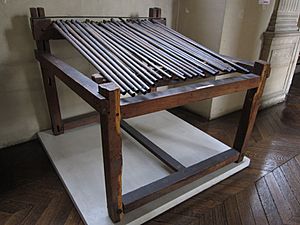Édouard Mortier, Duke of Trévise facts for kids
Quick facts for kids
Édouard Mortier
|
|
|---|---|

Portrait by Édouard Dubufe
|
|
| Prime Minister of France | |
| In office 18 November 1834 – 12 March 1835 |
|
| Monarch | Louis Philippe I |
| Preceded by | Hugues-Bernard Maret, duc de Bassano |
| Succeeded by | Victor, 3rd duc de Broglie |
| Personal details | |
| Born | 13 February 1768 Le Cateau-Cambrésis |
| Died | 28 July 1835 (aged 67) Paris |
| Resting place | Père Lachaise Cemetery |
| Political party | Non-Partisan |
| Awards | Grand Cordon of the Legion of Honor Grand Cross of the Military Order of Jesus Christ Duke of the Empire |
| Signature |  |
Adolphe Édouard Casimir Joseph Mortier (born 13 February 1768 – died 28 July 1835) was a famous French military leader. He became a Marshal of the Empire under Napoleon I. He fought in both the French Revolutionary Wars and the Napoleonic Wars. In 1835, he was one of 18 people killed during an attack on King Louis Philippe I.
Contents
Early Life and Military Start
Édouard Mortier was born in Le Cateau-Cambrésis, France, on February 13, 1768. His father was Charles Mortier. Édouard joined the army in 1791 as a sub-lieutenant. This was his first step into a long military career.
Fighting in the French Wars
Mortier fought in the French Revolutionary Wars from 1792 to 1793. He served in the northeastern part of France and in the Netherlands. Later, he fought along the Meuse and Rhine rivers.
He successfully helped negotiate the surrender of the Fortress of Mainz. In 1799, during the War of the Second Coalition, he was promoted quickly. He became a general of brigade and then a general of division.
Becoming a Marshal
During the Second Battle of Zurich, Mortier led 8,000 soldiers in an attack. His leadership in taking over Hanover impressed Napoleon. Because of this, Napoleon made Mortier one of the first marshals in 1804. A marshal was a very high-ranking military officer.
Battles with Napoleon's Army
Mortier led a group of soldiers called a "corps" in Napoleon's main army, the Grande Armée. He showed great skill in the Battle of Ulm.
Later, during the campaign that ended with the Battle of Austerlitz, Mortier was given command of a new corps. He marched his troops too far ahead and did not protect his side. A combined Russian and Austrian force tricked his soldiers. General Théodore Maxime Gazan's division was caught in a valley. Luckily, another division arrived just in time to help. This was the Battle of Dürrenstein in November 1805. Both sides had many losses. After this, Mortier was given a different assignment.
Campaigns in Prussia
In 1806, when the War of the Fourth Coalition began, Mortier again led the VIII Corps. Napoleon ordered him to work with Louis Bonaparte's troops. Their mission was to conquer the Electorate of Hesse. On November 1, the French army took over Kassel, the capital city.
Mortier then helped clear out Prussian forces. The city of Hamelin surrendered in November, with 10,000 Prussian soldiers. Nienburg also fell, and 2,911 Prussian soldiers were captured. In 1807, Mortier was involved in the Battle of Friedland and the sieges of Stralsund and Kolberg.
Duke of Treviso and Later Wars
In 1808, Napoleon gave Mortier the special title of Duke of Treviso. This was an honorary title. Soon after, Mortier led an army corps to help Napoleon take back Madrid in Spain.
He stayed in Spain for two more campaigns. He won an important victory at Battle of Ocaña in November 1809. From 1812 to 1813, he commanded the Imperial Guard, which was Napoleon's elite group of soldiers. In 1814, he bravely protected the army's rear during difficult battles. In 1815, during Napoleon's return to power (the Cent Jours), Mortier again led the Imperial Guard. However, he became very ill with sciatica and could not fight in the Battle of Waterloo.
After the Wars
After Napoleon's final defeat, Mortier faced some difficulties. But in 1819, he was allowed to rejoin the Chamber of Peers, a group of important people in government. In 1825, he received the Order of the Holy Spirit, a very high honor.
From 1830 to 1831, he served as the Ambassador of France to Russia. Then, from 1834 to 1835, he became the Minister of War and the President of the Council of Ministers. This meant he was a very important political leader.
Death of a Marshal
On July 28, 1835, Mortier was with King Louis-Philippe at a parade in Paris. This event celebrated the July Revolution of 1830. As the royal group passed along the Boulevard du Temple, shots were fired from a house window. Eighteen people were killed, including Mortier, and 22 were hurt. The king only had a minor injury.
The weapon used was a homemade volley gun. It was built by Giuseppe Marco Fieschi to try and kill the king. This device had 25 musket barrels fixed to a wooden frame, designed to fire all at once. Four of the barrels burst when fired, hurting Fieschi. He was quickly caught and later put on trial. Fieschi and two others were executed in February 1836.
Family Life
Mortier married Eve Anne Hymmès. They had six children together:
- Caroline Mortier de Trevise (1800–1842)
- Sophie Malvina Joséphine Mortier de Trévise (born 1803)
- Napoléon Mortier de Trévise (1804–1869), who became the 2nd Duke of Trévise
- Edouard (1806–1815)
- Louise (1811–1831)
- Eve-Stéphanie Mortier de Trévise (1814–1831)
See also
 In Spanish: Édouard Mortier para niños
In Spanish: Édouard Mortier para niños


